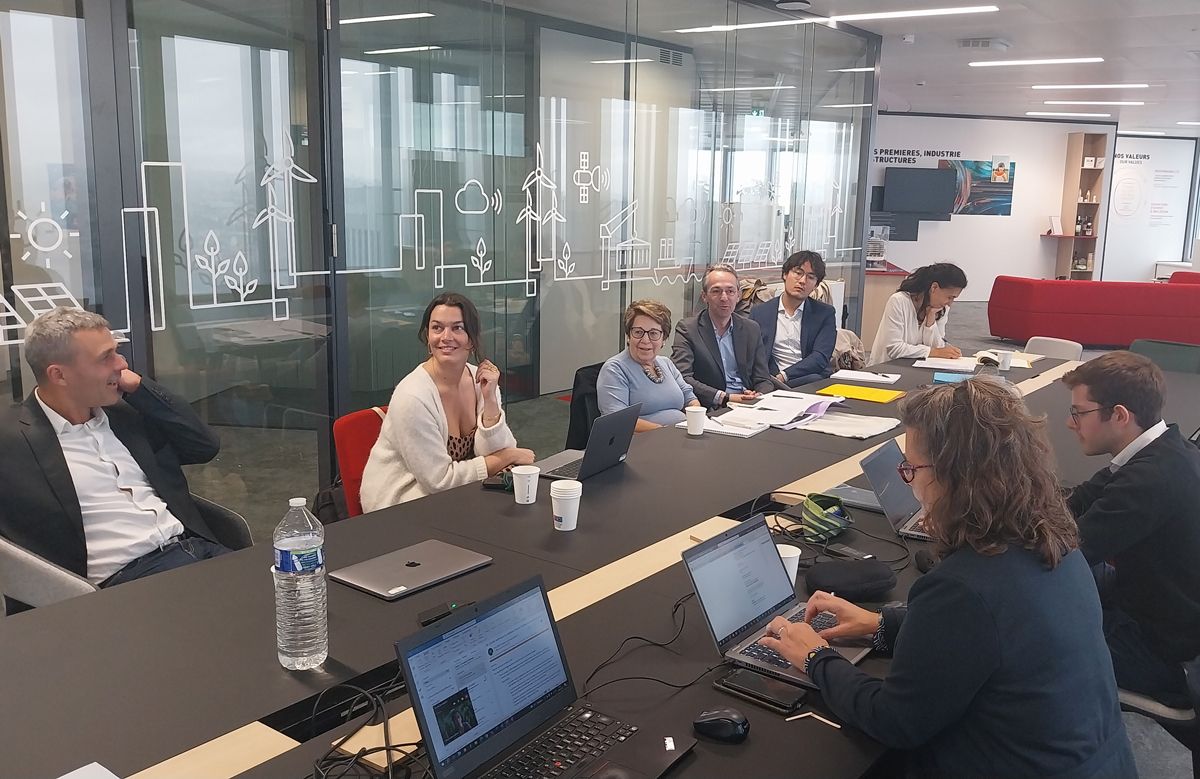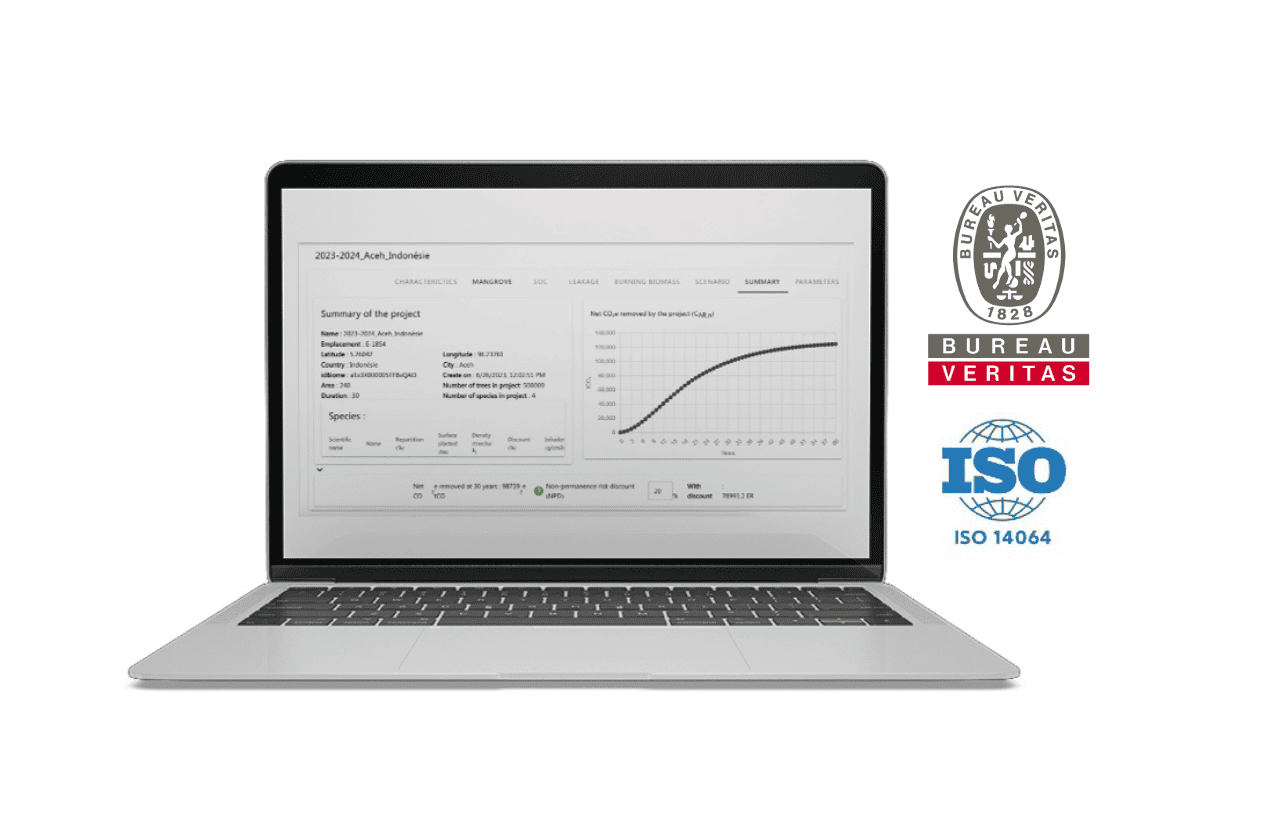Projections for the impact of our forestry and agroforestry projects and measuring them over time has been one of the pillars of our activities. Technological innovation now opens up new perspectives for us, complementary to studies on site. Internally developed by the Innovation and Impact Hub, our tool for prior projection of carbon sequestration in our projects uses internationally recognised technologies. Since September 2023, this tool, and the method it applies has been validated by Bureau Veritas. It will be complemented by other projection tools currently under development which will assess the projects’ impact on biodiversity, on the socio-economic environment, soils and water, as well as their potential stability.
A method and a tool validated by Bureau Veritas
Reforest’Action has developed a method and a tool for projecting carbon sequestration
In order better to fulfil its mission to regenerate ecosystems, Reforest’Action relies on its experience in the field but also on science and technology. Internally, the aim of our Innovation and Impact Hub is to estimate and measure the environmental and socio-economic benefits of our programmes over time. From 2023, our impact calculations are defined from the outset of the conceptualisation phase of projects, depending on their context, type, and challenges. They are allocated based on the four pillars of multifunctionality by which Reforest'Action characterises the stability of ecosystems: climate, biodiversity, the soil-water system, and human well-being.
With the purpose of optimising project design and measuring their impact on climate in particular, Reforest’Action’s Innovation and Impact Hub has since 2022 been working towards conceiving a projection method and carbon sequestration tool. This simulator has been operational since the summer of 2023. It makes it possible to project the carbon sequestration in our forestry and agroforestry projects in temperate and tropical zones in advance (before sequestration has taken place). In other words, the purpose of the tool is to provide an estimate of carbon storage for each project in terms of its conceptualisation and locality and give an estimated figure for potential carbon storage in the equivalent number of tonnes of CO2 sequestrated over 30 years. Thereafter, the data gathered during the long-term project monitoring makes it possible to confirm or adjust the carbon storage trajectory and to improve the data estimate used by the tool.
To obtain validation from an independent third party concerning the compliance of the tool with international standards, we requested an external audit be carried out by Bureau Veritas, which confirmed the particular significance of Reforest’Action’s vision of sustainability of ecosystems and conservation of biodiversity and to the committed and ambitious nature of our project.
Validation by Bureau Veritas guarantees compliance of the Reforest’Action carbon tool
Bureau Veritas Certification is a specialised auditing body in accordance with recognised certification processes, following international norms or particular specifications. Approached by Reforest’Action for the validation of carbon projection tool, Bureau Veritas in the first instance embarked on an operational and technical audit of the method conceived by Reforest’Action as well as the tool itself. Following recommendations made by Bureau Veritas and applied by Reforest’Action’s Innovation and Impact Hub, to improve the tool, the auditors gave a favourable opinion.
Thereafter, a validation committee convened on Thursday 21 September 2023 in the presence of Bureau Veritas auditors and interested third parties, amongst whom were, notably Corinne Lepage, former Minister of the Environment and European parliamentarian and three other collaborators from the Environmental Advocate’s practice, Huglo Lepage. After this committee meeting, Reforest’Action received a certificate of validation of its method and calculation tool, issued by Bureau Veritas in terms of the ISO 14064-3 standard which is applicable to the measurement of emissions or storage of greenhouse gases.


How will Reforest’Action apply carbon projection to its forestry projects?
On what benchmarks do Reforest’Action’s method and carbon simulation tool rely?
Our method is based on two guidelines of the Clean Development Mechanism (CDM), the first international carbon financing system conceived in terms of the Kyoto protocol by the United Nations Organisation (UNO): the AR-ACM0003 methodology, applicable to reforestation projects and forestation of land masses (except wetlands), and the AR-AM0014 methodology, which applies to reforestation projects and forestation of degraded mangrove ecosystems.
These methodologies determine the rules of evaluating sequestration of greenhouse gases which may apply to different kinds of ecosystems: commercial or secondary forests, agroforest ecosystems or mangroves. Thanks to the growth and management patterns inherent in each species of tree, it is possible to estimate the biomass (volume of living trees) in the project over time and a calculation of the quantity of carbon sequestrated at the various stages of the project’s progress.
Reforest’Action’s carbon simulation tool articulates international methodologies and applies them to meet our internal operational needs. It was developed by Carole Renner in the Innovation and Impact Hub, and then digitalised to be more effective for all Reforest’Action technical teams. Our evaluation method complies with voluntary commercial quality standards namely:
- Additionality: carbon sequestration would not take place without implementation of the project
- Measurability: carbon storage is quantified in accordance with methodologies approved in terms of international standards
- Permanence: carbon storage is perennial and irreversible for a period of at least 30 years
- Validation by an independent third party: the projection method and tool are validated by an accredited third party
What are the prerequisites for all carbon simulation in our projects?
Before any advance estimate of carbon sequestration comprised in our forestry and agroforestry projects, three pre-conditions must be fulfilled.
- Stratification of the projects. Since each simulation must take place on plots which are homogenous in terms of the conception of the project, initial conditions, and climate conditions, it is necessary to stratify the projects – in other words, to subdivide them, if necessary, in several separate homogeneous sub-plots.
- The determination of a buffer. In order to take account of the risks of the non-permanence of the project (for instance as a result of fire, or a climatic disaster), a buffer must be established to reduce the final value of the CO2 equivalent tonnage calculated. This buffer can be calculated, for example, thanks to the guidelines of the AFOLU Non-Permanence Risk Tool, contained in the VCS (Voluntary Carbon Standard) international carbon standard. The default position of Reforest’Action is to apply a buffer value of 20%. This means the buffer is conservative in the light of our experience of carbon certification
- The determination of a reference scenario and of a project design. A "project design" must be determined and compared to a "reference scenario" which corresponds with what the site would become in the absence of the project. The comparison between the "reference scenario" and the “project scenario” makes it possible to estimate the additional sequestration caused by the project, and, thus not to overestimate the true impact of the project on the climate.
Which elements are included in the calculation of sequestrated CO2 on a Reforest’Action project?
The elements which contribute to carbon sequestration in the reference scenario and the project scenario are referred to as “carbon sinks” or “sequestration compartments” which are as follows:
- Aerial biomass, which is to say woody biomass living above soil, including the trunk and branches of trees and bushes. The methodology for calculating carbon sequestrated in aerial biomass varies depending on the function and type of the project (commercial or secondary forests, agroforestry ecosystems or mangroves).
- Underground biomass: which is to say all biomass comprising living roots, estimated following an equation proposed by the Intergovernmental Panel on Climate Change (IPCC) for all these types of projects (except mangroves for which a different equation is applicable due to the specificity of their root systems).
- Organic carbon in soils, which means carbon sequestrated principally though the decomposition of vegetable matter in the soil, which comprises at least 50% of the organic material in the soil (before oxygen, hydrogen, nitrogen, and sulphur). The calculation depends on the soil type; all the factors and materials used for this estimate obtained through CDM methodology.
- Wood products, which means the ensemble of wood products (wood harvested to produce energy, for paper, light construction, or lumber) resulting from the harvesting of forests; this element of sequestration is taken into consideration only in the case of commercial forests. The duration and persistence of carbon storage in wood products depends on their quality and is modelled thanks to an equation recommended by the European Commission.
- Dead wood, comprising dead trees, whether still standing or fallen onto the ground and dead roots; and litter which is mainly constituted by dead leaves, twigs and branches covering the forest floor. These two compartments, which are optional depending on reference purposes as well as for the scope of the project are calculable as a proportion of living biomass, depending on climatic characteristics.
Elements which contribute to the liberation of carbon in the scope of the project are also considered for evaluating the quantity of CO2 which may be released into the atmosphere:
- Combustion of biomass; this is considered in prior estimates where fire is used for site preparation or for site clearance. The calculation thus only involves the emissions of greenhouse gases excluding CO2, since emissions of CO2 have already been accounted for as a loss of biomass.
- Leakage of greenhouse gases; these occur during activities prior to a project which must be removed for the implementation of such project, and emit more greenhouse gases as a result (in the case, for example, of the removal of livestock which would cause over-grazing of the project site).
Through the Reforest’Action carbon projection tool, net absorption of greenhouse gases is thus calculated for all elements which, within the terms of reference and the scope of the project, contribute to carbon sequestration. Finally, the objective is not only to take into consideration the supplementary absorption of greenhouse gases permitted by project activities. In concrete terms, once all the information has been gathered, the tool is then able to make a projection for the equivalent number of tonnes of CO2 sequestrated by a project over the course of time, to restore its value within 30 years.
Carbon projection has already been proposed to those of our clients who wish to contribute to the regeneration of ecosystems. Reforest’Action provides an advance indication of the equivalent number of tonnes of CO2 sequestrated over 30 years, on each project financed, and undertakes to verify a priori, thanks to data collected on the ground and through tele-detection, whether the carbon storage trajectory is in line with its initial estimates. This ex post evaluation will be confirmed by a Bureau Veritas audit mandated by Reforest’Action. Thus, in September 2023, the first contributors undertook to finance Reforest’Action projects on which the carbon sequestration curves were modelled using our tool. Even though this does not lead to the issue of carbon credits, it nevertheless allows enterprises that wish to engage in a climate contribution approach to understand the impact of the projects they support. This is what Reforest’Action is proposing with the support of Bureau Veritas within the framework of the ISO 14064-3 international standards.